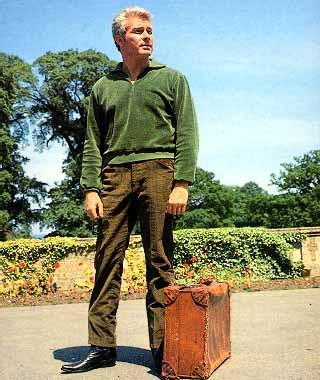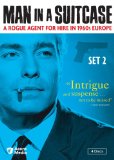| Reviews & Columns |
|
Reviews DVD TV on DVD Blu-ray 4K UHD International DVDs In Theaters Reviews by Studio Video Games Features Collector Series DVDs Easter Egg Database Interviews DVD Talk Radio Feature Articles Columns Anime Talk DVD Savant Horror DVDs The M.O.D. Squad Art House HD Talk Silent DVD
|
DVD Talk Forum |
|
|
| Resources |
|
DVD Price Search Customer Service #'s RCE Info Links |
|
Columns
|
|
|
Man in a Suitcase - Set 2
In its fourth season Danger Man made the transition from black & white to color, but only two episodes were produced, "Koroshi" and "Shinda Shima." At this point McGoohan was itching to move on to something new and more challenging, and because he was ITC's single biggest asset, studio head Lew Grade permitted his star to walk away from Danger Man with just two shows completed so he could develop an entirely new show. That new show eventually became The Prisoner, an innovative, unique, sort-of continuation in the story of John Drake, though he's never called that on The Prisoner.
(McGoohan left Danger Man at the right time, too. While even the last black and white episodes of Danger Man are pretty good, both "Koroshi" and "Shinda Shima" are truly terrible.)
Meanwhile, Grade was anxious not to waste the money, efforts, and personnel already invested in the production of Danger Man. One Danger Man script and many of that show's personnel made the transition to The Prisoner, while another Danger Man teleplay was reworked for another ITC show, The Champions.
However, ITC still needed another series to replace Danger Man, and thus Man in a Suitcase was born. It is, in many respects, a continuation of Danger Man with but cosmetic differences. It's considerably better than "Koroshi" and "Shinda Shima" however, and at its best is nearly as good as Danger Man was in its prime. Ultimately, it has the same assets and drawbacks as other ITC shows from this period (also including The Saint, The Baron, and, a bit later, The Persuaders!, Jason King, and The Protectors). It's an extremely handsome, lavishly appointed series with top guest stars and character players, and generally it's more subtle and adult than similar American TV spy/private eye shows. But ITC's programs were also pretty interchangeable. A script for The Baron might just as easily function as one for Danger Man or Man in a Suitcase. The sets, situations, and even the guest casts all begin to look alike after a while, with each series truly distinguished only by its star. Fortunately, ITC knew how to pick leading men, and Man in a Suitcase is no exception.
Acorn Media's Man in a Suitcase - Set 2 features the last 15 of 30 produced episodes, plus photo galleries and a 69-minute interview with series star Richard Bradford. The transfers are good but not great.
A pre-Hawaii Five-O Jack Lord had been considered, probably because he played CIA agent Felix Leiter in Dr. No (1962) and his austere acting style was similar to McGoohan's. In the end, however, Method actor Richard Bradford, another American, was chosen. Twenty-nine years old at the time, Bradford's prematurely gray hair made him look somewhat older than he was, though his youthful facial features and brooding manner also suggested a not-quite middle-aged James Dean, an actor whom Bradford admired.
In Man in a Suitcase Bradford plays McGill, a former U.S. intelligence agent, unjustly disgraced some years earlier and now living out of his suitcase, as it were, accepting freelance investigation and bounty hunter assignments. For this reason, and because the spy genre itself had become pessimistic when it hadn't fallen into the depths of self-parody (more often the latter), Man in a Suitcase is darker than The Saint or The Baron, and more suggestive of the general direction Danger Man seemed to be taking prior to McGoohan's departure.
To its credit, the series is more realistic in its depiction of violence while its good and bad guys tend to be various shades of gray rather than the usual stark black and white. "The Whisper" is a typical example, with McGill hired on by African plantation owner Marcus Spencer (Patrick Allen) when Jesuit priest Father Loyola (Colin Blakely) appears to be stealing money and/or otherwise influencing the discontented indigenous workers. McGill discovers Loyola is actually a former mercenary and mass murderer, yet by the end of the episode the audience has a lot of sympathy for him and very little for bigot Spencer and his wife.
Despite its globetrotting (or at least Europe-Africa-Middle East-trotting) scripts, like other ITC shows from this period, Man in a Suitcase was shot entirely in England, with Pinewood's backlot doubling for various exotic settings. ITC, however, did this quite well, and the entire production is slick and movie-like.
Bradford is an interesting actor. His style is very subdued, the kind of persona that outwardly appears almost disinterested but inwardly is constantly sizing up people and situations, as if playing poker. His Actors Studio training, apparently, was also behind the show's more realistic approach to violence, particularly against his person.
Casts and crews moving freely between 35mm filmed television and British theatrical films made the show, including directors Charler Crichton, Don Chaffey, Jeremy Summers, Charles Frend, Robert Tronson, Freddie Francis, and Peter Duffell. Future Bond director John Glen edited many of the episodes as well as directed one included in this set.
Guest stars this half-season include Sam Kydd, Ursula Howells, Duncan Lamont, Donald Sutherland, Rex Everhart, Peter Arne, Jacqueline Pearce, Marius Goring, Felicity Kendal, Peter Arne, Allan Cuthbertson, Peter Halliday, Jennifer Jayne, Ray McAnnally, Terence Alexander, Derek Francis, Ferdy Mayne, Robert Hutton, Colin Jeavons, Gay Hamilton, Philip Madoc, and Edward Fox.
Video & Audio
Man in a Suitcase looks reasonably good on DVD, better than the region 1 DVD of ITC's The Baron but not as good as, say, the otherwise inferior The Persuaders!. Episodes appear to be derived from slightly outdated masters, the kind of thing that would have looked great in 2000 but in late-2011 could look better. The 15 shows are on four discs with decent Dolby Digital mono audio (English only) and optional SDH subtitles.
Extra Features
Supplements include decent photo galleries, and a long, very static interview with actor Bradford, almost unrecognizable all these decades later until he talks - then that unmistakable delivery elicits recognition.
Parting Thoughts
An above average spy/detective series with the usual ITC polish and a slightly unusual edginess, Man in a Suitcase - Set 2 is enthusiastically Recommended.
Film historian Stuart Galbraith IV's latest book, Japanese Cinema, is on sale now.
|
| Popular Reviews |
| Sponsored Links |
|
|
| Sponsored Links |
|
|
| Release List | Reviews | Shop | Newsletter | Forum | DVD Giveaways | Blu-Ray | Advertise |
|
Copyright 2024 DVDTalk.com All Rights Reserved. Legal Info, Privacy Policy, Terms of Use,
Manage Preferences,
Your Privacy Choices | |||||||















